Des Moines farmers' market
I broke the journey back from St. Paul into two legs, was later than planned getting out of town, and that put me in downtown Des Moines Saturday morning. I didn't have time for a look around on the way up, so I took time on the way back. I last passed through in 1995, and since Des Moines has been cited as a model of downtown redevelopment -- remember Bill LaFortune's "No more! to Des Moines" at the BOK Center groundbreaking? -- I was curious to see what was new.
I found the Iowa Events Center, cited six years ago by Whirled sports columnist Dave Sittler as a compelling reason for Tulsa to build a new downtown arena. The nearby area was as dead as can be -- parking ramps, parking lots, office buildings. The arena sits near the river, but turns its back to it.
There's a beautifully hideous modern building nearby, designed in the 1960s by the famed firm of Skidmore, Owings and Merrill, with a beautifully hideous sculpture garden. I could imagine a progressive Des Moiner (?) being quite proud that the city has such a place, but preferring never to spend any time there.
One of the sculptures, not in the garden, but in a kind of sunken plaza, was actually rather cool: A large golden sphere, with part of its skin ripped away to reveal gears inside. Couldn't find out the name of the piece or its sculpture. As interesting as it was, it reminded me uncomfortably of the sphere that once stood on the World Trade Center plaza, mangled by the 9/11 disaster, and now reinstalled in Battery Park.
I parked near the new baseball stadium, Principal Park, which is next to the river and "in" downtown, but doesn't really connect to either. The stadium is surrounded by surface parking. An old warehouse building nearby has been converted to lofts, but then it's a few blocks to the next nearest retail or residential development.
(More about downtown Des Moines, and more photos, after the jump.)
The river isn't much to look at anyway -- no trees, just grassy berms on either side, and a bike path. It's more like a canal. It's a fairly narrow river, dividing downtown to the west from Capitol Hill to the east, but bridges are frequent. Federal-style government buildings face each other across the river.
On my way south to the stadium, I saw a lot of foot traffic and what looked like a street fair. Coming back north, I found the Des Moines Downtown Farmers' Market, which occupies a four-block stretch of Court Street, plus two blocks each of 2nd and 4th Streets, from the old county courthouse to the river, every Saturday morning from early May to late October.
It was interesting but not surprising that the market was not held near the arena or in the ballpark parking lot or along the river. Instead, it was in perhaps the most interesting part of downtown, an area where old buildings had been converted to lofts with retail and restaurants on the first floor. New infill buildings were built to fit in with the old. Once again, old buildings -- not rivers or ballparks or arenas -- are the key ingredient to lively streetscapes.
I was also struck by the contrast between this farmers' market and others I've visited. Some vegetable stands and so-called farmers' markets involve people selling the same produce you get in the supermarket, shipped in from across the country. At more urban farmers' markets, most of the booths seem to sell artisanal, organic, gourmet, heirloom versions of the same stuff you can get at the supermarket, but at twice the price. I don't care if you take WIC or food stamps, someone on assistance isn't going to pay $4 for a loaf of bread. Neither am I.
A real farmers' market should have farmers selling their produce direct to the consumer at or below supermarket prices, because you're cutting out several layers of middlemen. Farmers earn more money, consumers get fresher produce for the same or better prices. Most of the booths at Des Moines seemed to offer this kind of product, but you still found booths with the artisanal, organic, gourmet, heirloom stuff.
A number of booths were run by Asian farm families. One such booth specialized in root vegetables -- beets, carrots, radishes, turnips, ginger, etc.
I spent $7 on a 5 lb. bag of locally-grown Gala apples, $6 for a dozen ears of "peaches and cream" sweet corn, $1 for a bunch of radishes, $1 for a bunch of beets, and $2 for a small container of cucumbers. The apples were a good deal, at least.
After I put the groceries in the car, I went back to get some lunch and do some writing at Java Joe's coffee house. They're open late and not far off the highway, so (along with Linden Street Coffee in Lamoni) this could be a nice late night place for a coffee break when driving through Iowa.
0 TrackBacks
Listed below are links to blogs that reference this entry: Des Moines farmers' market.
TrackBack URL for this entry: https://www.batesline.com/cgi-bin/mt/mt-tb.cgi/4394

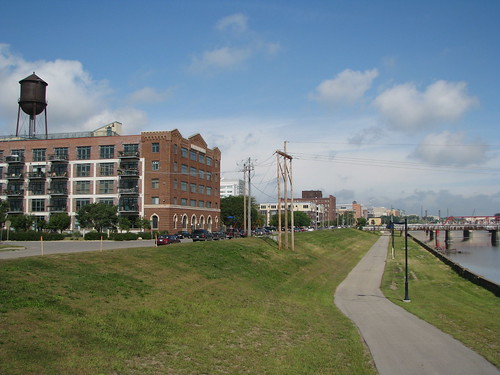
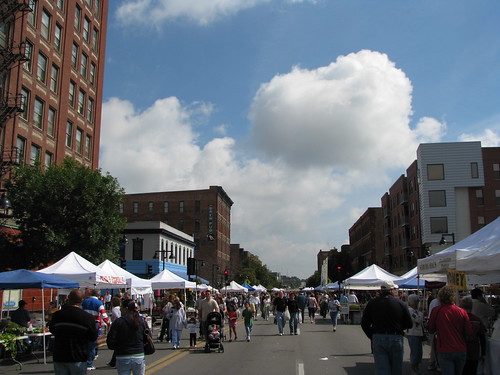
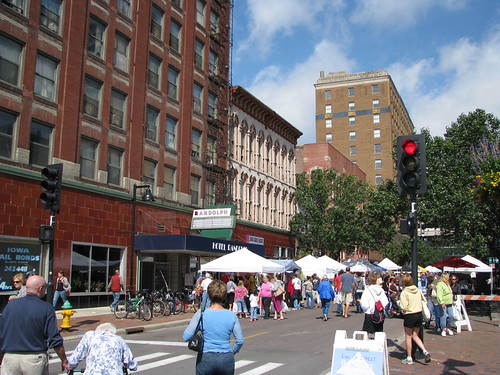
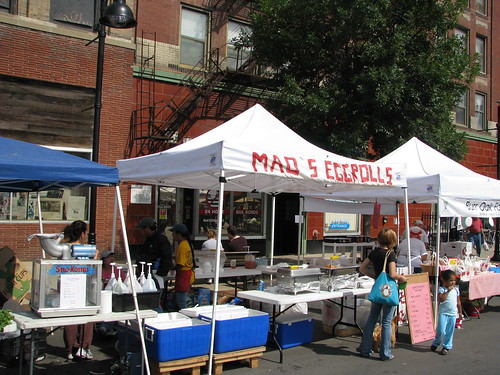

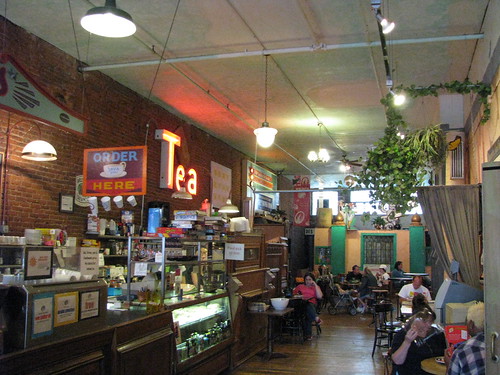
This piece points out one major feax pas in the Tulsa Elite's thinking about the placement of these projects. First, both the arena and Driller park (the new one) would be best placed near or on the river, thus killing two development birds with one taxation stone. Second, it is a good idea to develope the areas around these venues. Des Moines did not realize this, the people ramming the ballpark seem to have realized it. But, the way in which the properties around the new ballpark are being procurred is heavy handed and downright wrong.
In short, Tulsa could have had river development and connected that to downtown with a little open mindedness.
You wrote: "A real farmers' market should have farmers selling their produce direct to the consumer at or below supermarket prices, because you're cutting out several layers of middlemen. Farmers earn more money, consumers get fresher produce for the same or better prices."
Although it's true that you're cutting out several middlemen, there are other cost factors that are not reflected in supermarket food and which you're not considering.
Much of the food you find at the supermarket is picked by disempowered people working for a pittance without any benefits or job security. In the U.S., those people are often illegal immigrants. In other countries, they may be people who had been subsistence farmers at one time but who are now growing for a foreign market for shrinking wages.
It is also often heavily-laden with pesticides and herbicides to cut down further on the labor costs. Environmental damage or the health damage to you or your children from those toxins are not figured into those costs, either.
Water is another resource which, until now, has been considered "free" in most places but is now becoming a scarcer, more valuable resource. Many crops in the fertile California valley, for example, are grown with very high water inputs in an area that is otherwise a desert.
Risk is another cost not well represented. When a warehouse purchases produce, for example, they have many different suppliers to choose from and can go all over the world for their purchases. If an apple crop fails due to drought in eastern Washington, the warehouse can purchase from New Zealand instead.
As the cost of petroleum goes up and up, the supermarket costs (which rely heavily on cheap transportation) will go up. What will we do if we don't have a local food infrastructure that can provide us with the calories we need to survive? (No--our local food infrastructure could not currently provide for our needs.) This shows that the issue of "food security" also has a cost that we're not currently bearing.
But back to your argument.... As a regular farmers' market shopper, I will disagree with you that food purchased at the market is more expensive. First, you used a $4 loaf of bread as "proof" of these high costs. I hate to tell you, but a farmer didn't grow that loaf of bread. Bread is made from the agricultural product wheat and it is likely that the baker you bought bread from was not the wheat farmer. Obviously, you know this already, and must agree that it defeats your premise. The costs you complained about are the same kind of costs you find with any artisanal product. Whether or not it was a fair price for an artisanal product is another discussion (with some of the same arguments), but it doesn't belong in this one about farmers.
You might find this flyer interesting: http://www.kerrcenter.com/pdf/busting-a-myth.pdf It is taken from a longer article, which you can find on the same website if you want to read it. It shows a price comparison done on a single day between farmers' market produce and supermarket produce. In the article, you can read about some of the reasons why. (Ex: a difference in the weight of same-size produce, due to dehydration and degradation in quality; difference in pricing strategies--per pound vs. per piece, etc.)
Another factor that I'm sure you're aware of is the difference to your local economy when spending money on a product produced locally vs. sending it out of your community. Money spent on farmers' market produce keeps a very large percentage of your money circulating in our local economy, benefiting us all.
I've never been a farmer, but I've grown a garden from time to time and, knowing the work involved, I NEVER feel like farmers' market produce is over-priced. In fact, I always feel I'm getting a bargain.
I hope to see you shopping at the local farmers' markets!